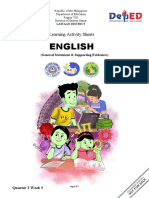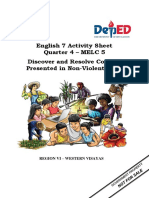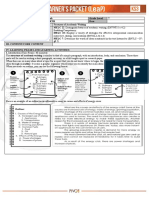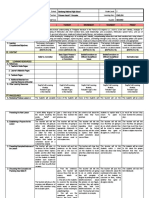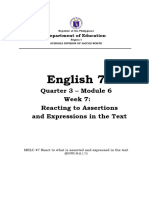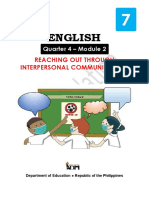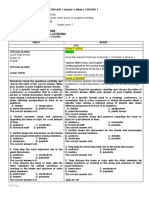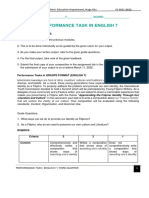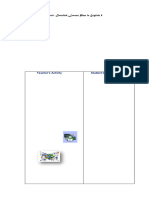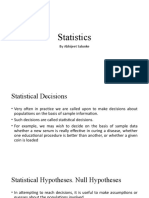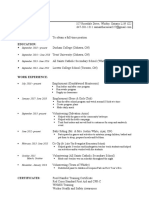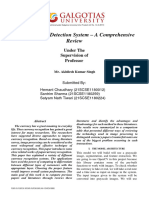English 7: Quarter 4 Week 4 Activity Sheet Learning Competencies: Language Topic
English 7: Quarter 4 Week 4 Activity Sheet Learning Competencies: Language Topic
Uploaded by
Ryuk The ShinigamiCopyright:
Available Formats
English 7: Quarter 4 Week 4 Activity Sheet Learning Competencies: Language Topic
English 7: Quarter 4 Week 4 Activity Sheet Learning Competencies: Language Topic
Uploaded by
Ryuk The ShinigamiOriginal Title
Copyright
Available Formats
Share this document
Did you find this document useful?
Is this content inappropriate?
Copyright:
Available Formats
English 7: Quarter 4 Week 4 Activity Sheet Learning Competencies: Language Topic
English 7: Quarter 4 Week 4 Activity Sheet Learning Competencies: Language Topic
Uploaded by
Ryuk The ShinigamiCopyright:
Available Formats
ENGLISH 7
QUARTER 4 WEEK 4
Activity Sheet
Learning Competencies:
Determine the truthfulness and accuracy of the material viewed. (EN7VC-I-h-10)
Language Topic:
The truthfulness and accuracy of the material viewed.
Name:_____________________________________________ Grade & Section:____________________
Parent’s Signature:________________________________ Date accomplished: ________________
Day 1
Initial Task 1: Review on variety of strategies for effective
interpersonal communication.
Directions: Identify the word/words being described in each number. Choose the word from the pool
of words. Write your answers on your pad paper.
A. Siren C. Filter
B. Rattling D. Distractions
E. Determine
_________ 1. It is a piece of equipment that produces a loud, high-pitched warning sound.
_________ 2. It is to officially decide especially because of evidence or facts: to establish
exactly or with authority.
_________ 3. It is a device that prevents some kinds of light, sound, electronic noises from
passing through.
_________ 4. It is something that makes it difficult to think or pay attention.
_________ 5. It is a series of short, sharp knocking sounds
Initial Task 2. Pre-test
Directions: Read the statements carefully. Write true if the statement is correct and write false if it
is
incorrect. Write your answers in your English notebook.
____________ 1. All materials viewed on tv and internet present an accurate information.
____________ 2. The news that you see on tv is true.
____________ 3. There are some sources of information whose purpose is to mislead and misinform.
____________ 4. It is important to evaluate the sources and information you hear and see.
____________ 5. Accuracy means not only getting the objectively verifiable ‘facts’ right - names, places,
dates of birth, and quotes.
____________ 6. Taking notes are not essential while viewing a material.
____________ 7. Knowing where an author/reporter is coming from is not important in judging what
they
have to say.
____________ 8. Something in print in any form does not make it accurate and factual.
____________ 9. It is a bad idea to read or listen to many different stories, or reports, on the same
issue/subject to help you determine where the truth lies.
___________ 10. Truthful and honest communication plays a critical role in what is best in human
endeavors.
Day 2
Initial Task 3. Vid Viewing
Directions: Watch and listen to the video and answer some guide questions in your
notebook.
1. What is the video all about?
2. Where and when do we usually see this clip?
3. What is the video clip trying to tell you?
4. According to the speaker in the video, can you believe all the things that you hear and watch in the
television or in the internet? Why?
Day 3
Study Notes:
Truth is the reality behind facts. Facts are the available data.
Accuracy means not only getting the objectively verifiable ‘fact’ right – names, places, dates of
birth, quotes, the results of sporting fixtures – but accurately reporting opinions expressed by those
who you report.
Here are some of the indications that information viewed is accurate and true.
1. The same information can be found in other reliable sources.
Take notes of the main facts presented in the material viewed. Compare it with
multiple sources. Are the information or facts presented present in other sources? If the
information is the same in multiple sources then you have a truthful and accurate
information.
2. The sources used for documentation are known to be generally reliable.
Establishing the accuracy of multimedia sources can be challenging because they often
represent a combination of facts, opinions and perspectives from different individuals. Do not
trust anonymous sources.
3. The author of the information is known to have expertise on that subject.
Determining the knowledge and expertise of the subject or the speaker in a multimedia
source is very important. Anyone can make an assertion or a statement about something but
only someone who knows that thing can make a reasonably reliable statement or assertion
about it. Research the person who is making the statement.
4. The presentation is free from logical fallacies or errors.
An important aspect of accuracy is the intellectual integrity of the item. Errors of logic
occur primarily in the presentation of conclusions, opinions, interpretations, editorials, ideas,
etc.
5. Quotations are “in context’” – the meaning of the original work is kept in the work which quotes the
original.
Statements quoted in the material viewed must be quoted correctly and accurately. If it
is used in context or in the material viewed, the meaning of the original statement must be
kept and no opinion and assumptions about it should be made.
Here are some indications that information may not be accurate and not true:
1. Facts cannot be verified or are contradicted on the other sources.
2. Sources used are known to be unreliable or highly biased.
3. Sources used or cited is inadequate or non-existent.
4. Quotations are taken out of context and given a different meaning.
5. Presence of one or more logical fallacies.
Day 4
Discovery Task 1. Compare and Contrast
Directions: Watch the two (2) different clips from the link below or from the cd tape/flash drive given
to you by your teacher. Using the venn diagram below write the information that are
present in both clips and the information that are only found in each clip. Write your
answer in your answer sheet.
Video clip 1:
https://www.youtube.com/watch?v=l3GKr0jNmyM
Video Clip 2:
https://www.youtube.com/watch?v=iQMWybcPJek
CLIP 1 CLIP 2
BOTH
Day 5
Discovery Task 2: Let’s summarize!
Directions: Below is the checklist of the indicators used to determine the accuracy and truthfulness of
the material viewed. Check the column where the indicators belong .
INDICATORS ACCURATE NOT ACCURATE
1. Quotations are “in context’” – the
meaning of the original work is kept
in the work which quotes the original.
2. Quotations are taken out of context
and given a different meaning.
3. Presence of one or more logical
fallacies.
4. Facts cannot be verified or are
contradicted on the other sources
5. The sources used for documentation
are known to be generally reliable.
6. The author of the information is
known to have expertise on that
subject.
7. The presentation is free from logical
fallacies
Or errors.
8. Sources used are known to be
unreliable or highly biased.
9. Sources used or cited is inadequate
or
Non-existent.
10. The same information can be found
in
other reliable sources
Discovery Task 3:
Directions: Complete the table below. Use what you have learned in the discussion in filling out the
table. Copy and answer the table in your notebook.
DEFINITION
1. Truth
2. Accuracy
3. Facts
4. Source
5. Quotation
Day 6
Summative test:
A. Identification
Directions: Read each statement below. Identify what is asked. Choose your answer from the
words inside the box.
accuracy truth quotation
source author error of logic
__________ 1. Words or statements used that are taken from the original source.
__________ 2. It is the origin of the facts or information presented in the material viewed.
__________ 3. The reality behind facts.
__________4. It is the occurrence of assumptions and opinions to some information.
__________5. It is the available data.
__________6. The speaker or the subject that has expertise of the available data.
__________7. This means not only getting the objectively verifiable ‘fact’ right but accurately reporting
opinions expressed by those who you report.
__________8. If this is without fallacies and errors the material is considered truthful and accurate.
__________9. A material viewed that presents on side of the information or with personal opinion is
considered _______.
__________10. A good source of information is truthful and accurate if the facts are also present in
other _______ sources.
B. True or false.
Directions: Read the statements carefully. Write true if the statement is correct and write false if it is
incorrect.
__________1. Statements quoted in the material viewed must be quoted correctly and accurately.
__________2. An important aspect of accuracy is the intellectual integrity of the item.
__________3. You should not take note of the main facts presented in the material viewed.
__________4. Determining the knowledge and expertise of the subject or the speaker in a multimedia
source is very important.
__________5. You should not trust anonymous sources.
Answer Key
Review Pre-test Vid Viewing Discovery Task 1. Compare and
1. A. Siren 1. False (Opinions may vary) Contrast
2. E. Detremine 2. True Possible answers:
3. True (Opinions may vary)
3. C. Filter 1. The video is all about how false
4. True news can spread.
4. D. Distractions 5. True 2. This clip can be seen usually in
5. B. Rattling 6. True the internet.
7. False 3. The video clip is trying to tell us
8. False that not all news presents true
9. False and real facts.
10. True 4. According to the speaker in the
video clip we should not believe
everything that we hear and saw
in the television it is because
some are misinformation.
Discovery Task 2: Let’s summarize!
Discovery Task 3:
1. accurate (Opinions may vary)
2. not accurate
3. not accurate
4. not accurate
5. accurate
6. accurate
7. accurate
8. not accurate
9. not accurate
10. accurate
You might also like
- English 7 - Quarter 3 - Mod7 - Raising Sensible Challenging Thought Provoking Questions in Public Forums Panel Discussions EtcDocument18 pagesEnglish 7 - Quarter 3 - Mod7 - Raising Sensible Challenging Thought Provoking Questions in Public Forums Panel Discussions Etcrose vina guevarra100% (2)
- English: Quarter 4 - Module 4Document23 pagesEnglish: Quarter 4 - Module 4oxy0m.0oron100% (4)
- English 7: Quarter 3 - Module 1: Using Correct and Appropriate Multimedia ResourcesDocument15 pagesEnglish 7: Quarter 3 - Module 1: Using Correct and Appropriate Multimedia ResourcesCharity Anne Camille Penaloza100% (1)
- English: Learning Activity SheetsDocument7 pagesEnglish: Learning Activity SheetsPrila NunezNo ratings yet
- English 7: Using Appropriate Oral Language, Stance, and BehaviorDocument5 pagesEnglish 7: Using Appropriate Oral Language, Stance, and BehaviorMarjun Casas100% (8)
- English: Quarter 4 - Module 4Document23 pagesEnglish: Quarter 4 - Module 4Ryuk The Shinigami100% (6)
- English: Understanding The Value of Responsibility and Cooperation in A Literary TextDocument24 pagesEnglish: Understanding The Value of Responsibility and Cooperation in A Literary TextRyuk The Shinigami50% (2)
- SCGX Fino UserguideDocument189 pagesSCGX Fino UserguideWashington JohnNo ratings yet
- English 7: Department of EducationDocument6 pagesEnglish 7: Department of EducationMr crab raveNo ratings yet
- Learning Area Grade Level Quarter Date: English 7 7 4Document4 pagesLearning Area Grade Level Quarter Date: English 7 7 4Aliah LeosalaNo ratings yet
- English 7 Activity Sheet Quarter 4 - MELC 5 Discover and Resolve Conflict Presented in Non-Violent WaysDocument7 pagesEnglish 7 Activity Sheet Quarter 4 - MELC 5 Discover and Resolve Conflict Presented in Non-Violent WaysTrinity Marie100% (1)
- English Quarter 4-Module 5 Types of Literary Conflicts and Their Non-Violent SolutionsDocument14 pagesEnglish Quarter 4-Module 5 Types of Literary Conflicts and Their Non-Violent Solutionsoxy0m.0oronNo ratings yet
- Determining The Truthfulness and Accuracy of The Materials ViewedDocument35 pagesDetermining The Truthfulness and Accuracy of The Materials ViewedSalvador Thome LapsoNo ratings yet
- Determining Truthfulness and Accuracy of The Material ViewedDocument38 pagesDetermining Truthfulness and Accuracy of The Material ViewedMailyn T. NgitngitNo ratings yet
- QUARTER 3 Summative Test English 7Document6 pagesQUARTER 3 Summative Test English 7Ladylyn Punzalan - SusiNo ratings yet
- G7 ENGLISH LeaP WEEK1 Q4 MergedDocument6 pagesG7 ENGLISH LeaP WEEK1 Q4 MergedJa NI SA100% (2)
- DLL Express Ones BeliefsDocument5 pagesDLL Express Ones BeliefsLeomarr Ysrael Arzadon DisayNo ratings yet
- Determining The Truthfulness and Accuracy of The Materials ViewedDocument19 pagesDetermining The Truthfulness and Accuracy of The Materials ViewedGerald Rosario FerrerNo ratings yet
- English 7 Quarter 3 Module 4 Version 4Document26 pagesEnglish 7 Quarter 3 Module 4 Version 4Shiela Mae PongosNo ratings yet
- Eng7 - q3 - Mod4 - Express One's BeliefsConvictions Based On A Material ViewedDocument18 pagesEng7 - q3 - Mod4 - Express One's BeliefsConvictions Based On A Material ViewedMikko Gomez60% (5)
- Express One's Beliefs Convictions Based On A Material ViewedDocument19 pagesExpress One's Beliefs Convictions Based On A Material Viewedsheryl ann dionicio100% (2)
- Lesson Exemplar - Belief and ConvictionDocument6 pagesLesson Exemplar - Belief and ConvictionJade Jayawon100% (1)
- English: Quarter 4 - Module 3: Determining The Worth of Ideas Mentioned in Text Listened ToDocument15 pagesEnglish: Quarter 4 - Module 3: Determining The Worth of Ideas Mentioned in Text Listened ToChoi Soo-binNo ratings yet
- Final English 7 SLM 4 Quarter 4Document16 pagesFinal English 7 SLM 4 Quarter 4Ghen Marmito Costales100% (3)
- QRTR 3 MODULE 3 Explaining How A Selection May Be Influenced by Culture, History, Environment, or Other FactorsDocument13 pagesQRTR 3 MODULE 3 Explaining How A Selection May Be Influenced by Culture, History, Environment, or Other FactorsKaren Domondon0% (1)
- Q3 English 7 Module 2Document32 pagesQ3 English 7 Module 2Nicole Claire Tan Dazo50% (2)
- At The End of The Lesson, Learners Are Expected ToDocument5 pagesAt The End of The Lesson, Learners Are Expected ToMeLanie Miranda CaraanNo ratings yet
- English 7 Quarter 4 Week 5 Las 1Document2 pagesEnglish 7 Quarter 4 Week 5 Las 1Kemberly Semaña Penton100% (2)
- DLL 3rD QUARTER - React To What Is Asserted or Expressed in A TextDocument3 pagesDLL 3rD QUARTER - React To What Is Asserted or Expressed in A TextAriane del RosarioNo ratings yet
- Daily Lesson Plan: School Grade Level 7Document3 pagesDaily Lesson Plan: School Grade Level 7Ms Rose Ann BautistaNo ratings yet
- Dlp-Panel Discussion-InterventionDocument9 pagesDlp-Panel Discussion-InterventionFSENGLISHMORTA, ROSE-ANN A.No ratings yet
- PANEL DISCUSSIONS (Final)Document30 pagesPANEL DISCUSSIONS (Final)Alyssa Jean Monceda100% (1)
- English: Quarter 4 Module 6Document23 pagesEnglish: Quarter 4 Module 6Ryuk The ShinigamiNo ratings yet
- Melc 2Document4 pagesMelc 2Bea LocsinNo ratings yet
- Citing Evidence To Support A General Statement: English 7 Activity Sheet Quarter 3 - MELC 5Document8 pagesCiting Evidence To Support A General Statement: English 7 Activity Sheet Quarter 3 - MELC 5Shirley Morangil TamzNo ratings yet
- English 7 Activity Sheet: Quarter 3 - MELC 2Document14 pagesEnglish 7 Activity Sheet: Quarter 3 - MELC 2Ludovina Calcaña100% (2)
- Lesson Plan in English 7Document5 pagesLesson Plan in English 7Claire ReazolNo ratings yet
- Summative Test (Listening Strategies/Locating Specific Sources)Document4 pagesSummative Test (Listening Strategies/Locating Specific Sources)Mary Jane Solis100% (1)
- React On What Is Asserted LP EDITED AND FINAL To Be PrintedDocument8 pagesReact On What Is Asserted LP EDITED AND FINAL To Be PrintedEUNICE RIVAS100% (3)
- English 7: Quarter 3 - Module 1 Multi-Media ResourcesDocument5 pagesEnglish 7: Quarter 3 - Module 1 Multi-Media ResourcesJodie PortugalNo ratings yet
- ENGLISH+7+Q3+Module+6 Week+7 React+to+What+is+Asserted+or+Expressed+in+a+Text FINALDocument22 pagesENGLISH+7+Q3+Module+6 Week+7 React+to+What+is+Asserted+or+Expressed+in+a+Text FINALNicky Joy CentenaNo ratings yet
- English 7 Types of Literary Conflicts and Their Non-Violent SolutionsDocument15 pagesEnglish 7 Types of Literary Conflicts and Their Non-Violent SolutionsGweendolinNo ratings yet
- English: Reaching Out Through Interpersonal CommunicationDocument26 pagesEnglish: Reaching Out Through Interpersonal Communicationoxy0m.0oron100% (7)
- ENGLISH 7 Quarter 4 Lesson 1Document6 pagesENGLISH 7 Quarter 4 Lesson 1Alleli Faith Leyritana100% (1)
- Department of Education: Demonstration Lesson PlanDocument5 pagesDepartment of Education: Demonstration Lesson PlanBrigette Darren Baste ColitaNo ratings yet
- Determining The Worth of IdeasDocument35 pagesDetermining The Worth of IdeasGerald Rosario FerrerNo ratings yet
- English: Quarter 4 - Module 2Document24 pagesEnglish: Quarter 4 - Module 2gerlie maeNo ratings yet
- Basic Factors of DeliveryDocument44 pagesBasic Factors of DeliveryJade Jayawon100% (1)
- Semi-Detailed Lesson Plan For Oral Langauge Use For Specific PurposesDocument7 pagesSemi-Detailed Lesson Plan For Oral Langauge Use For Specific PurposesNicole Mercadejas NialaNo ratings yet
- English 7 Performance Task 3RD QuarterDocument2 pagesEnglish 7 Performance Task 3RD QuarteryuriboyNo ratings yet
- Belief and ConvictionDocument3 pagesBelief and ConvictionDivine Grace AbainzaNo ratings yet
- Beliefs and ConvictionDocument1 pageBeliefs and ConvictionMailyn T. Ngitngit0% (1)
- Grade 7 USE CORRECT AND APPROPRIATE MULTI MEDIA RESOURCES WHEN ORALLY GIVING INFORMATION INSTRUCTION MAKING EXPLANATIONS AND NARRATING EVENTS IN PERSONAL OR FACTUAL RECOUNTSDocument5 pagesGrade 7 USE CORRECT AND APPROPRIATE MULTI MEDIA RESOURCES WHEN ORALLY GIVING INFORMATION INSTRUCTION MAKING EXPLANATIONS AND NARRATING EVENTS IN PERSONAL OR FACTUAL RECOUNTSSky Love Faith AblañaNo ratings yet
- Grade 7 ENG LAS MELC 1 Week 1. QTR 2Document5 pagesGrade 7 ENG LAS MELC 1 Week 1. QTR 2Stvn RvloNo ratings yet
- 3-13-19 Express One's Beliefs or Convictions Based On A Material ViewedDocument2 pages3-13-19 Express One's Beliefs or Convictions Based On A Material ViewedMarianne Florendo GamillaNo ratings yet
- Learning Area Grade Level Quarter Date: English 7 4Document4 pagesLearning Area Grade Level Quarter Date: English 7 4Aliah LeosalaNo ratings yet
- LP On Reacting To What Is Asserted or Expressed in A Text 1Document7 pagesLP On Reacting To What Is Asserted or Expressed in A Text 1Ange SandaNo ratings yet
- DLL RTOT Day 5Document2 pagesDLL RTOT Day 5JanetteMaribbayPasicolanNo ratings yet
- Identifying Influence of Culture History and EnvironmentDocument24 pagesIdentifying Influence of Culture History and EnvironmentVhel Avelino100% (1)
- English 7 Q3 Week 2Document4 pagesEnglish 7 Q3 Week 2BernadettePimentel100% (2)
- Week 2 English 7 Determining The Truthfulness and Accuracy of The MaterialDocument2 pagesWeek 2 English 7 Determining The Truthfulness and Accuracy of The MaterialMyvic ImperialNo ratings yet
- Grade9 LP - R - 081204Document4 pagesGrade9 LP - R - 081204alona.ruizNo ratings yet
- English: Quarter 4 - Module 4Document9 pagesEnglish: Quarter 4 - Module 4Rose Ann ZimaraNo ratings yet
- Ict Q4W3-W4 Activity SheetsDocument19 pagesIct Q4W3-W4 Activity SheetsRyuk The ShinigamiNo ratings yet
- Science 7 Activity Sheets q4 Week2Document6 pagesScience 7 Activity Sheets q4 Week2Ryuk The ShinigamiNo ratings yet
- English: Quarter 4 Module 6Document23 pagesEnglish: Quarter 4 Module 6Ryuk The ShinigamiNo ratings yet
- Ict 7 Q3W8Document24 pagesIct 7 Q3W8Ryuk The ShinigamiNo ratings yet
- Manual Transmisor de Flujo - F-1000Document6 pagesManual Transmisor de Flujo - F-1000ErikaNo ratings yet
- CV Template IOSHDocument2 pagesCV Template IOSHjashnNo ratings yet
- Statistics 1Document34 pagesStatistics 1Abhishek GuptaNo ratings yet
- FitzmyerDocument18 pagesFitzmyerbajaNo ratings yet
- Right Classbook 6 PDFDocument96 pagesRight Classbook 6 PDFnadhiawpNo ratings yet
- John P. Priecko Resume - Current EditionDocument4 pagesJohn P. Priecko Resume - Current EditionJohn P. PrieckoNo ratings yet
- Pm-Clinic Data Sheet Wa180-3L Base Information: Customer Name LocationDocument3 pagesPm-Clinic Data Sheet Wa180-3L Base Information: Customer Name LocationjulianoNo ratings yet
- LogDocument26 pagesLogmarselameiNo ratings yet
- Flcd-Mod-Itf WaDocument20 pagesFlcd-Mod-Itf WaAmanjot KaurNo ratings yet
- Quiz Chapter 1Document14 pagesQuiz Chapter 1mahdiNo ratings yet
- Unit1 Anh (LT)Document9 pagesUnit1 Anh (LT)Yến HảiNo ratings yet
- BiomechanicsDocument1 pageBiomechanicsNey CampoNo ratings yet
- Question Bank PHM 505 Electromagnetic Theory B.SC. Hons. (Physics) 2018 - 2019Document3 pagesQuestion Bank PHM 505 Electromagnetic Theory B.SC. Hons. (Physics) 2018 - 2019Abhishek YadavNo ratings yet
- Samantha CassarDocument1 pageSamantha Cassarapi-506346106No ratings yet
- Pmbok® Guide 7 Edition: Ricardo Vargas Explains TheDocument1 pagePmbok® Guide 7 Edition: Ricardo Vargas Explains TheRatnadeep GhoshNo ratings yet
- Types of ConcentrationDocument2 pagesTypes of ConcentrationYana Allison GrandeNo ratings yet
- Evshop - Eu TC Charger 1,8 KW PDFDocument5 pagesEvshop - Eu TC Charger 1,8 KW PDFhambi1986No ratings yet
- Doctor of Medicine (MD) ProgramDocument16 pagesDoctor of Medicine (MD) ProgramKSU LibraryNo ratings yet
- Terna Engineering College: LAB Manual Part ADocument7 pagesTerna Engineering College: LAB Manual Part APrathmesh GaikwadNo ratings yet
- Business Standard - 01 June 2020 PDFDocument15 pagesBusiness Standard - 01 June 2020 PDFSurbhi SabharwalNo ratings yet
- Brand Extension ProjectDocument21 pagesBrand Extension ProjectSohaib ArifNo ratings yet
- BT3272 Research PaperDocument2 pagesBT3272 Research PaperHarshit SharmaNo ratings yet
- Sri LankDocument20 pagesSri LankVangeesa SumanasekaraNo ratings yet
- 1st Presenter - Group 6Document34 pages1st Presenter - Group 6Alex LuminariasNo ratings yet
- Wind Turbine Control With Multiple Model Predictive ControlDocument6 pagesWind Turbine Control With Multiple Model Predictive ControlAngelo Sanchez IafantiNo ratings yet
- Instructions For Digitrip RMS 510 Trip Unit: Instruction Leaflet I. L. 29-885DDocument20 pagesInstructions For Digitrip RMS 510 Trip Unit: Instruction Leaflet I. L. 29-885DRajeelNo ratings yet
- Cement Kiln RefractoryDocument3 pagesCement Kiln Refractoryengr kazamNo ratings yet
- What Is Emotional IntelligenceDocument2 pagesWhat Is Emotional IntelligenceNuzhat TabassumNo ratings yet
- Unit - 6 - Transaction and Recovery ManagementDocument96 pagesUnit - 6 - Transaction and Recovery ManagementAaliya SharmaNo ratings yet



